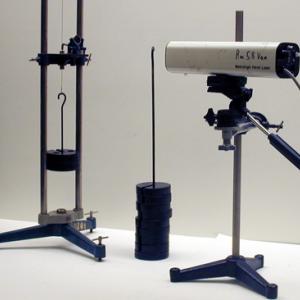College of Liberal Arts & Sciences
1R20.15 - Young's Modulus
NOTE: The device is too tall to get into the room when it is sitting on the table.
The apparatus is set so that we are going to measure the stretch of a 1 meter length of wire (1 meter measured without tension). Once the apparatus is set on the table, mount the optical lever and align the laser so that you get a reflected dot on the screen. Start adding 1k weights to the hanger at the bottom of the wire. The dots should progressively move up the screen with the addition of each weight.
- Jae June Noh, Soyeon Kim, Jung Bog Kim, "Measurement of Young's Modulus Using a Michelson Interferometer", TPT, Vol. 61, #7, Oct. 2023, p. 618.
- Austin D. Korff and Alan J. Scott, "World’s Simplest Materials Lab", TPT, Vol. 56, #9, Dec. 2018, p. 614.
- Robert D. Polak, Adam R. V. Davenport, Andrew Fischer, Jared Rafferty, "Determining Young's modulus by measuring guitar string frequency", TPT, Vol. 56, #2, Feb. 2018, p. 122.
- Kenneth A. Pestka II, "Young's Modules of a Marshmallow", TPT, Vol. 46, #3, Mar. 2008, p. 140.
- Kenneth A. Pestka II, "The Elastic Constant", TPT, Vol. 45, #6, Sept. 2007, p. 327.
- W. Larry Freeman, and Ronald F. Freda, "A Simple Experiment for Determining the Elastic Constant of a Fine Wire", TPT, Vol. 45, #4, Apr. 2007, p. 224.
- Adam Niculescu and Russell Shumaker, "Apparatus for Measuring Young's Modulus", TPT, Vol. 41, #6, Sept. 2003, p. 364.
- A. P. French, "The Suspended Slinky - A Problem in Static Equilibrium", TPT, Vol. 32, #4, Apr. 1994, p. 244.
- Zheng Bunker, "An Improved Optical Lever", TPT, Vol. 31, #8, Nov. 1993, p. 510.
- Thomas B. Greenslade, Jr. and Richard Wilcox, "An Inexpensive Young's Modulus Apparatus", TPT, Vol. 31, #2, Feb. 1993, p. 116.
- James E. Kettler, "Listening for Young's Modulus", TPT, Vol. 29, #8, Nov. 1991, p. 538.
- James E. Kettler, "An Elasticity Paradox", TPT, Vol. 28, #6, Sept. 1990, p. 416.
- R.T. Curry, "Turning the Young's' Modulus Experiment Around", TPT, Vol. 21, #2, Feb. 1983, p. 112.
- A. Kshatriya, "Laser Beam Optical Lever", TPT, Vol. 12, #8, Nov. 1974, p. 501.
- J. Flores-Maldonado, S. Galindo, and H. Jimenez-Dominguez, "Erratum: 'Consistency of Minimum Time and Length Intervals with Special Relativity' [Am. J. Phys. 55, 1041 (1987)]", AJP, Vol. 56, #9, Sep. 1988, p. 856.
- J. Flores-Maldonado, S. Galindo, and H. Jimenez-Dominguez, "Note on an Apparatus for Young's Modulus Measurement", AJP, Vol. 55, #7, July 1987, p. 664.
- Gauri Shanker, V. K. Gupta, B. Saraf, and N. K. Sharma, "Temperature Variation of Modulus of Rigidity and Internal Friction: An Experiment with Torsional Oscillator", AJP, Vol. 53, #12, Dec. 1985, p. 1192.
- Somdev Tyagi, Arthur E. Lord Jr., "Simple and Inexpensive Apparatus for Young's Modulus Measurement", AJP, Vol. 48, #3, March 1980, p. 205.
- T. G. Bullen, "Determination of Young's Modulus in the Freshman Laboratory", AJP Vol. 33, #10, Oct. 1965, p. 855.
- T. Kallard, "Optical Lever", Exploring Laser Light, p. 43.
- "Young's Modulus of Elasticity: Measurement of Stretch with Optical Lever", Selective Experiments in Physics, CENCO, 1941.
- "Young's Modulus of Elasticity: Direct Measurement of Stretch with a Micrometer Screw and Level", Selective Experiments in Physics, CENCO, 1941.
- "Deflection of a Beam - Young's Modulus", Selective Experiments in Physics, CENCO, 1941.
- W. Bolton, "Stress Analysis Using Resistance Strain Gauges", Book I - Properties of Materials, Physics Experiments and Projects, 1968, p. 64.
- W. Bolton, "Rubber at Low Temperatures", Book I - Properties of Materials, Physics Experiments and Projects, 1968, p. 64.
- W. Bolton, "The Strength of Glass Fibres", Book I - Properties of Materials, Physics Experiments and Projects, 1968, p. 62 - 63.
- W. Bolton, "The Dynamic Young's Modulus of Rubber", Book I - Properties of Materials, Physics Experiments and Projects, 1968, p. 14 - 15.
- W. Bolton, "The Elasticity of Copper", Book I - Properties of Materials, Physics Experiments and Projects, 1968, p. 12 -13.
- W. Bolton, "Poisson's Ratio", Book I - Properties of Materials, Physics Experiments and Projects, 1968, p. 10 - 11.
- W. Bolton, "Strain", Book I - Properties of Materials, Physics Experiments and Projects, 1968, p. 9.
- W. Bolton, "Stress", Book I - Properties of Materials, Physics Experiments and Projects, 1968, p. 7 - 8.
Disclaimer: These demonstrations are provided only for illustrative use by persons affiliated with The University of Iowa and only under the direction of a trained instructor or physicist. The University of Iowa is not responsible for demonstrations performed by those using their own equipment or who choose to use this reference material for their own purpose. The demonstrations included here are within the public domain and can be found in materials contained in libraries, bookstores, and through electronic sources. Performing all or any portion of any of these demonstrations, with or without revisions not depicted here entails inherent risks. These risks include, without limitation, bodily injury (and possibly death), including risks to health that may be temporary or permanent and that may exacerbate a pre-existing medical condition; and property loss or damage. Anyone performing any part of these demonstrations, even with revisions, knowingly and voluntarily assumes all risks associated with them.
